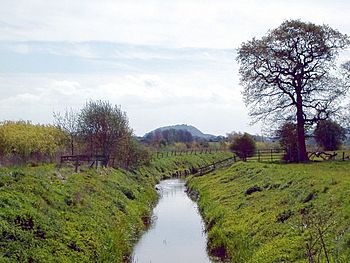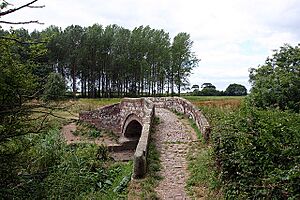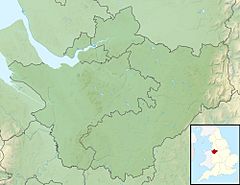River Gowy facts for kids
Quick facts for kids River Gowy |
|
|---|---|

The River Gowy at Foulk Stapleford
|
|
|
Location of the mouth within Cheshire
|
|
| Country | England |
| County | Cheshire |
| District | Cheshire West and Chester |
| Physical characteristics | |
| Main source | near Peckforton 53°05′56″N 2°41′02″W / 53.0988°N 2.6838°W |
| River mouth | confluence with River Mersey, Stanlow Refinery 53°17′29″N 2°51′08″W / 53.2914°N 2.8521°W |
| Length | 32 km (20 mi) |
The River Gowy is a river in Cheshire, England. It is a smaller river that flows into a larger one, the River Mersey.
The Gowy starts in the hills of western Cheshire, close to Peckforton Castle. It begins near where the River Weaver also starts. While the Weaver flows south, the Gowy flows north. For many miles, the Gowy's valley is used by the Shropshire Union Canal.
The river flows just east of the city of Chester. It then goes under the Manchester Ship Canal using a special tunnel called a syphon. After this, it joins the Mersey near Stanlow. The River Gowy is about 20 miles (32 km) long.
Contents
What Lives in the River Gowy?
The River Gowy is a popular spot for people who enjoy fishing. It is also home to several rare small creatures without backbones, called invertebrates.
Protecting River Life
In recent years, the lower parts of the river have faced pollution. This is partly because of the oil refinery at Stanlow. Also, nearby motorways like the M53 and M56 have contributed to the problem.
Because of this, environmental groups have started projects to clean up the area. They also work to bring back the fish population in the river.

Gowy Meadows Nature Reserve
The Gowy Meadows Nature Reserve was created in 2002. It stretches from the A5117 to the M56 motorway. This area is a river valley with wet grassland and meadows.
A Home for Wildlife
This nature reserve covers about 160 hectares (395 acres) of land. It is owned by Shell UK. The Cheshire Wildlife Trust helps manage it as a special place for nature.
Surveys by the Environment Agency show that the river's eel population is doing well. This is good news, as eel numbers have dropped a lot across Europe. Scientists are not sure why the Gowy's eels are thriving. Some local fishermen think it might be because the river's flow is partly closed off by the syphon system under the ship canal. This might change how the eels move around.
The River's Past Uses
Long ago, the River Gowy provided power for many watermills. At one time, there were up to 20 mills along its banks. These mills used the river's flow to grind grain or power other machines.
Remaining Mills Today
Today, only a few of these old mills are still around. These include Bates Mill and Walk Mill, which are privately owned. Bunbury Mill is now owned by a special trust. Trafford Mill is owned by United Utilities plc.
Bunbury Mill is sometimes open for people to visit. Trafford Mill is being turned into a museum. It will also be a place for learning and training about protecting nature.
How the River Has Changed
Over many centuries, the river's length has grown. This happened as people drained the marshy lands around it to create more usable land.
Tributaries of the Gowy
The River Gowy has several smaller streams that flow into it. These are called tributaries. They add water to the main river.
- Thornton Brook
- Mill Brook
- Back Brook
- Barrow Brook
- Milton Brook
- Waterless Brook
- Southley Brook
- Crimes Brook


